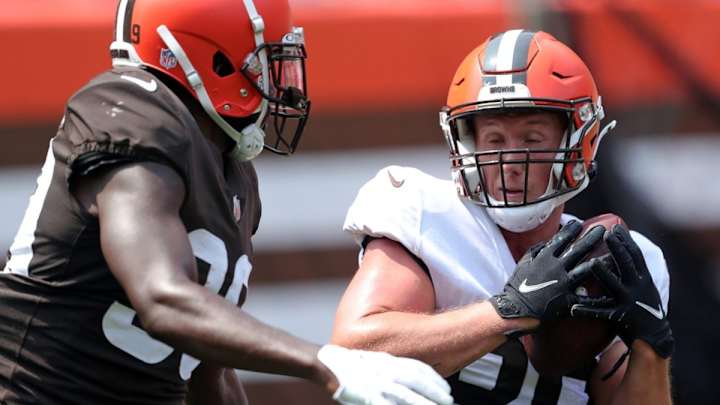Harrison Bryant's Added Strength Increases Viability

Harrison Bryant added 13 pounds over the offseason, which increases the ways he can contribute within the Cleveland Browns offense.
Coming out of Florida Atlantic University, Bryant was utilized often as a wing and H-back during his rookie season. He could play in space, block with angles, pull and shift within the formation.
Over the course of the season, he had some challenges keeping weight and then contracted COVID-19 at the end of the season. Tight end is such a difficult transition to the NFL as it requires the player to be able to run routes and catch passes while trying to block players like J.J. Watt, whom Bryant had to face and attempt to block as a rookie.
It's both a physically and mentally demanding position. Nevertheless, Bryant had a productive rookie season, both with some critical blocks as well as catching 24 passes for 238 yards and three touchdowns in 15 games.
Heading into year two heavier, but feeling confident he has not lost any athleticism (he doesn't have much to spare), Bryant can now potentially expand his role in the offense. Often an H-back and space player as a rookie, the increased size and strength makes him more viable as an inline option which could create more situations for him to be on the field and expand his role as a pass catcher.
Bryant has the necessary length to play inline and now he has more strength to go with it. Something tight ends coach Drew Petzing mentioned in his media availability on July 31st, that enables Bryant, Austin Hooper and David Njoku to play every aspect of the position.
In 2020, the Browns saw all three tight ends miss games at points, so having Bryant able to do more improves their depth as well as increasing their options when all three are healthy. As an example, the Browns could be in a situation where they attach both Hooper and Bryant on one side of the offensive line while putting Njoku out wide on the other to give a strong look for both the pass and the run.
Along with Stephen Carlson, the Browns appear pretty set at the tight end position this season. They might keep someone like Connor Davis on the practice squad if they can get him there because of his size and length that makes him basically a light weight tackle. Overall, Bryant's strength just makes the group better and more competitive.
Depending on the day of training camp, the pecking order for the tight end group can vary. Hooper is at least nominally the number one option but Njoku and Bryant both excelled in the Orange and Brown scrimmage on Saturday. That might change on a different day where Hooper stands out above the other two.
There are some slight differences in athleticism, but overall, the Browns tight end groups are both talented and interchangeable.
If Bryant can build on a promising rookie season and become a more well rounded threat in 2021, the Browns could be in fantastic shape both this season as well as for the future. Regardless of how the Browns handle Njoku's pending free agency or Hooper's contract, Bryant's rookie deal doesn't expire until after the 2023 season, which makes him a valuable player.
The wide receiver position is making an argument the Browns should utilize more personnel groups with three or more on the field at a time. This tight end group with a bulked up Harrison Bryant continues to make a compelling a case for continuing to employ a significant amount of multiple tight end formations.
READ MORE: Browns Prudent to Wait on Baker Mayfield Contract
